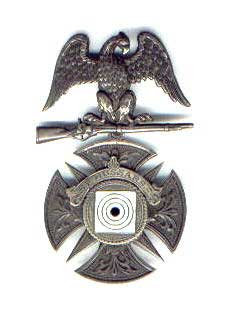
California National Guard Officer wearing the 1890 shooting medal and Type 1 Shooting Badge with 4 bars, probably 1887, 1888, 1889, and 1890 or 1891. Photo from Yas Yasinitsky, OMSA#1.
State Marksmanship Badges
As the National Guard became more closely aligned to the Federal Army, more importance was attached to marksmanship. Prior to 1884 funds for rifle practice in California were limited to from 5 to 10 rounds of ammunition per rifleman during annual target practice, and if a man was not present he was not allowed to make it up.
In the Report of Colonel Charles Sontag, Inspector-General of Rifle Practice for California dated Dec. 2, 1884, the Colonel urged the State Legislature to Appropriate sufficient funds to enable the National Guard to have at least 100,000 reloaded cartridges for target practice each year, and to provide a suitable rifle range for such practice. He called attention to the fact that the United States Army permitted each man 240 cartridges per year or 620 reloaded ones. The Colonel also stressed the fact that in order to effectively meet and defeat a determined foe, the National Guard should be able to properly handle the standard rifle (Model 1873 Trapdoor Springfield 45-70 caliber) and to shoot straight. This could not be accomplished on the small amount set aside for rifle practice in 1883. The highest score that year was 58% on the 200-yard range.
It appears that the State Legislature heeded the report of Colonel Sontage. For on March 12th 1885 the Legislature passed a law to appropriate $7,000.00 every biennium for the promotion of target practice, however, no money was set-aside until 1887. Then the State Legislature set aside $3,500 to be used for target practice for the years 1887 and 1888. This was only half the amount allowed by law. The Adjutant-General spent a portion of the money to purchase State Decorations, which were to be awarded to members of the National Guard for attaining certain percentages in target practice.
A decoration was adopted in 1887, produced by "George C. Shreve & Co." of San Francisco. This badge is the Type 1 model, which is a 1" diameter gilt bronze circlet, whose front design was a 3/4s Bear's head in the center and an inscription around the edge "NATIONAL GUARD OF CALIFORNIA * EUREKA *.On the back was the inscription "MILITARY" below which "AWARDED BY THE STATE TO" with a space for the recipients name and date of award, then the badge number, and below that "MARKSMANSHIP". At the bottom of the badge were two rings for the suspension of dated award bars for 1887, 1888, and 1889. These bars appear to all have been the bronze "Marksman" class. For those that exceeded the 80-90% range, it appears that a special silver medal with the year bar ribbon suspension was been awarded. Note: the author has never seen a dated bar for 1887-1889 that is anything other than the bronze "Marksman". Also three examples of the special medals all in silver have been seen with the dates 1889, and 1890. There may have been a gold version also (which the author has never seen nor heard of). These "Outstanding Marksmanship Medals" have the same medallion design as the type 1 badges, both front and back.
There are the regular medals (Type 1) for these years plus the special medals. The state changed the range firing from one day to two days and they were having trouble getting participants. Therefore, they added the medals as an extra incentive. The specials medals were given to the top firers for the first day and the regular medals for the second day. This information is in an AG report (courtesy of Brigadier General William Hamilton).
All these awards increased interest in marksmanship to the point that 688 of these badges were awarded for the year 1887. By 1895 the efficiency had increased to the point where 1,827 members were awarded marksmanship badges.
It appears that the dated award bars in different metals were not issued until 1891 with the Type 2 badges. The gold "Sharpshooter" for averaging 90% or better, silver "Rifleman" for averaging 80-90%, and bronze Marksman for those averaging 50-80%. These remained unchanged except that the gold bars appears later as the "Expert

Rifleman" or "Revolver Expert" and the silver bars appear as "Sharpshooter" or "Revolver 2nd Class" and there is also a bronze "Revolver 3rd Class" Bar. Another bar noted was a silver "First Class Rifleman" 1908.
|
|
|
|
|
|
|








 |
 |
|
|
|
|
|
|
|
 |
 |
|
|
|
|
|
|
|
|
|
|
|
|
|
|
|
2. Qualification Bars: Bars with the following inscriptions are currently authorized for display on the badges:
|
Rifle Machinegun Submachine Gun Rocket Launcher Small Bore Pistol |
Pistol Field Artillery Grenade Mortar Missile |
AA Artillery Tank Weapons Carbine Bayonet Aeroweapons |
Auto Rifle Flamethrower Recoilless Rifle Small Bore Rifle |
Inscription formerly authorized on qualification bars:
|
1921 Rifle - A Automatic Rifle C.A. Gunner 1922 Added Sword |
Rifle - B Pistol Inf Howitzer
Pistol - M |
Rifle - C Machine Gun F.A. Gunner
Pistol - D |
Rifle - D Mine Gunner
Delete Pistol |
|
1924 Consolidated all rifles to Rifle, added Machine Rifle, Tank Weapons, C.W.S. Weapons, Bayonet 1926 Added Aerial Gunner, Aerial Bomber 1928 Added Grenade 1941 Deleted Sword, added Small Bore Rifle, Small Bore Pistol, Submachine Gun, Small Bore MG. 1944 Added Carbine, Antitank, 81mm Mortar, 60 mm Mortar, TD 75mm, TD 57mm, TD 3 inch 1948 Added Recoilless Rifle, Mortar. Deleted Pistol D, Pistol M, Mines, C.W.S. Weapons, Aerial Gunner, Aerial bomber, Small Bore MG, Antitank, 81mm Mortar, 60mm Mortar, TD (all types) 1951 Added Submarine Mines 1972 Added Aeroweapons |
|||
Prior to 1951 regulation, the titles of the badges were Marksman and 2d Class Gunner; Sharpshooter and First Class Gunner and Expert.
Regimental Shooting Badges






